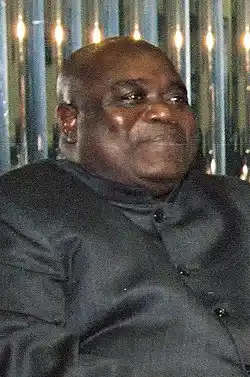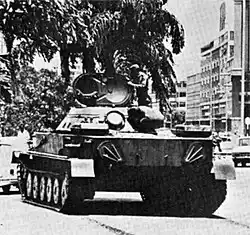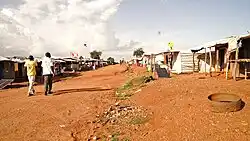The Second Congo War was a conflict which raged in the Democratic Republic of the Congo for nearly five years between 1998 and 2003. It was largely a continuation of the First Congo War that had occurred between late 1996 and the middle of 1997, however where the first war had been focused on removing the Zairean dictator, Joseph Mobutu, from power, the second war was a much broader conflict and dragged in a dozen other countries in Africa, destabilizing much of the sub-Saharan region in the process. As it unfolded, the war was fought over myriad different issues and in some places was an anarchic clash of regional warlords over mineral wealth in this vast African country. The death toll of the war and the level of dislocation associated with it were enormous. Approximately five and a half million people lost their lives during the fighting in the conflict zones, though the excess mortality caused by the war might have only been half this number, as disease and famine outbreaks would have occurred here in these years even without the further destabilizing effects of the war. Because of the violence involved in it, and the number of nations which were dragged into the conflict, the Second Congo War is sometimes termed the Great War of Africa or Africa’s Great War.[1]
Research your ancestors on MyHeritage
The Second Congo War chronology of eventsThe Second Congo War chronology of events

The Second Congo War was almost a direct continuation of the First Congo War. That conflict was fought between October 1996 and May 1997 over two issues; the desire of a coalition of Congolese militias and warlords led by Laurent-Désiré Kabila to fully remove the long-ruling dictator of Zaire, Joseph Mobutu, from power, and the Tutsi-dominated government of neighboring Rwanda’s wish to intervene in Zaire to remove the threat posed by Rwandan Hutus to Rwanda’s western border following the Rwandan genocide of 1994. This first conflict ended in the summer of 1997 with the flight of Mobutu into exile and the establishment of Kabila’s rule over the renamed Democratic Republic of the Congo.[2]
Within months of the end of the First Congo War, a new conflict was brewing, as the removal of Mobutu had only brought a temporary and superficial end to the conflict. A wide range of other issues now coalesced to create a much wider and destructive conflict. Some of these were internal to the Congo, notably the fact that for many years regional warlords and groups had de-facto ruled their own miniature states within the wider state. Kabila sought to reduce these to the control of the central government. More importantly, relations between Kabila and the Rwandan government that had been his ally in 1996 and 1997 quickly deteriorated and led to a fresh Rwandan invasion of eastern Congo. In the political chaos that prevailed in the Congo, rebels from the long-running civil wars of Burundi and Angola also found bases to operate out of within Congolese territory. This began to drag these countries into the conflict as well.[3]
In the late 1990s the conflict expanded ever further. For instance, Uganda became involved through a combination of its alliance with Rwanda and its own personal interests. Even countries without a direct border with the Democratic Republic, specifically Chad, Zimbabwe and Namibia, became players in the war, while others like Libya, Tanzania, Zambia and South Africa which did not directly send troops to fight in the conflict, did become embroiled in it diplomatically, logistically and financially. Little surprise that this was called the Great War of Africa.[4]

The conflict raged in its political phase for five years, largely pitting Kabila’s Congolese government, in alliance with Angola, Chad, Namibia and Zimbabwe, against Rwanda, Uganda and Burundi, who supported the Congolese rebels and other rebels such as the Angolan rebels operating on Congolese soil. Through the Pretoria Accords that were negotiated at the very end of 2002 and which came into effect in 2003, an uneasy peace was reached between the Congolese government, by then led by Joseph Kabila, successor to his assassinated father, and the rebel groups. Rwanda and Uganda agreed to withdraw their troops from the country, while the Pretoria agreement also made provisions for the Angolan Civil War, which had been underway since 1975, to come to an end.[5]
The Second Congo War is often said to have led to the deaths of five and a half million people. However, some analysts debate this figure, noting that several million people would probably have died here owing to disease outbreaks and famine during this time regardless of whether or not the war had compounded the situation. As such, the excess mortality associated with the war probably lies between two and three million people. Still, the suffering did not end in 2003, as the various armed forces withdrew into Rwanda and other countries. Such was the level of militarization and anarchy which prevailed in a country approximately the same size geographically as Germany, France and Spain combined, that endemic violence has continued to prevail across large parts of the Congo in the two decades since.[6]
Extent of migration associated with the Second Congo WarExtent of migration associated with the Second Congo War
Millions of people were displaced by the Second Congo War and the years of residual conflict which followed through the 2000s and into the early 2010s. Because the Congo is such a vast country, much of this displacement occurred internally, with hundreds of thousands of people moving out of regions of particularly intense conflict at one time and moving into another more stable region. The Kivu region in the far east of the country, for instance, has seen mass exoduses as people fled westwards into other parts of the Congo or over the eastern borders altogether into Rwanda, Burundi and Tanzania, a process which was compounded by Ebola outbreaks here in recent years. There are probably around a half million Congolese people living abroad who left the country during the Second Congo War itself, but the fighting and the exodus didn’t stop in 2003, merely the political stage of the conflict, and today, over twenty years after the official war ended, hundreds of thousands of people are still migrating as a result of the violence every year.[7]
Demographic impact of the Second Congo WarDemographic impact of the Second Congo War
The Congolese diaspora associated with the Second Congo War and the other conflicts in the Congo/Zaire in the 1990s, 2000s and 2010s is concentrated for the most part in a dozen or so countries. The bulk of these are the Congo’s immediate neighbors, particularly along its eastern borders, Uganda, Rwanda, Burundi, Tanzania and Zambia. An estimated 60,000 Congolese people are living in Zambia.[8] The figure is over 80,000 in neighboring Tanzania.[9] A similar number is recorded for Burundi, but given that this is a much smaller country, the concentration of Congolese refugees here is much denser.[10]

The situation in Rwanda is far more complex, given that hundreds of thousands of Hutu refugees had fled from Rwanda into Zaire in the mid-1990s and then fled back to Rwanda during the Congo Wars. Therefore the movement between eastern Congo and Rwanda has far exceeded that for Burundi, Tanzania and Zambia. Finally, Uganda is also its own unique case. In the period following the Second Congo War, as the endemic violence in the country has continued, Uganda has become the main destination for refugees fleeing over the eastern border. In 2022 alone, for example, over 90,000 Congolese refugees arrived to Uganda.[11] For a time in the 2000s, Angola to the south of the Congo was a major destination for refugees from the Congo, but in more recent years the Angolan government has engaged in mass expulsions of people from the Congo, forcibly removing over 300,000 people alone in the space of a few months in late 2018.[12]
Finally, beyond the main centers of migration in Uganda, Rwanda, Tanzania, Burundi and Zambia, the conflicts over the Congo since the 1990s have resulted in a diaspora further afield. Over 15,000 Congolese people live in the United States, while similar numbers can be found in both Canada and the United Kingdom. Several thousand Congolese refugees are also living in countries like Germany, the Netherlands, Switzerland and Italy. However, the largest centers of the Congolese diaspora outside of Africa itself are in Belgium and France. Well over 100,000 Congolese people live between these two countries, colonial ties to the region having created strong links therewith over the past century or so.[13]
See alsoSee also
Explore more about the Second Congo WarExplore more about the Second Congo War
- Eastern Congo: A Legacy of Intervention at the Council on Foreign Relations
- Explaining the Great War in Africa on JSTOR
- Democratic Republic of the Congo: A Migration History at the Migration Policy Institute
References
- ↑ https://www.cfr.org/timeline/eastern-congo-legacy-intervention
- ↑ https://www.cfr.org/global-conflict-tracker/conflict/violence-democratic-republic-congo
- ↑ https://www.cfr.org/timeline/eastern-congo-legacy-intervention
- ↑ Christopher Williams, ‘Explaining the Great War in Africa: How Conflict in the Congo Became a Continental Crisis’, in The Fletcher Forum of World Affairs, Vol. 37, No. 2 (Summer, 2013), pp. 81–100.
- ↑ https://www.theguardian.com/world/2002/jul/31/congo.chrismcgreal
- ↑ https://africasacountry.com/2024/02/the-drcs-never-ending-wars
- ↑ https://www.iom.int/news/record-high-displacement-drc-nearly-7-million
- ↑ https://www.unhcr.org/news/briefing-notes/nearly-6000-congolese-refugees-return-home-zambia-unhcr-support
- ↑ https://reporting.unhcr.org/sites/default/files/2018%20Congolese%20Situation%20SB%20-%20Tanzania.pdf
- ↑ Pamphile Mpabansi, ‘Congolese Refugees in Burundi: Challenges and Future Prospects’, in Open Journal of Social Sciences, Vol. 11, No. 4 (April, 2023).
- ↑ https://reliefweb.int/report/uganda/democratic-republic-congo-regional-refugee-response-plan-january-december-2023
- ↑ https://www.ohchr.org/en/press-releases/2018/10/mass-expulsions-angola-have-put-thousands-congolese-risk-drc-bachelet
- ↑ https://www.justicepaix.be/en/the-belgian-congolese-diaspora-and-belgian-development-cooperation/
